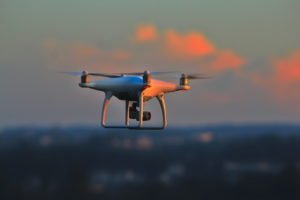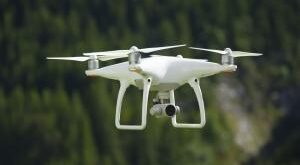In the final keynote address of DJI Airworks 2020, DJI’s VP of Policy and Legal Affairs Brendan Schulman spoke about the direction U.S. government drone regulation is taking – and spoke out against fear-based policies.
U.S. government drone regulation has increasingly focused on security, with drones in the cross-fire of the U.S.- China trade war. Regulations that propose to ban drone technology produced in China or with Chinese components are increasingly prominent in drone discussions – but Shulman says that fear-based regulations don’t stop there. If regulation is not based on rational data, Shulman says, everyone pays the price.
What’s Happened Since Part 107?
“… it wasn’t so long ago that almost everything you’ve heard about here at AirWorks was deemed illegal,” says Shulman, pointing out that prior to Part 107, commercial drone operation required a special exemption from U.S. government drone regulations. Part 107 was lauded as opening the doors to the commercial drone industry – and was developed in collaboration with industry stakeholders.
“But Part 107 was four years ago,” says Shulman. “And I hate to say it, but to many of you it’s obvious: That was America’s high-water mark for drone regulation… since then, progress on regulations has stagnated.”
Shulman points out that the FAA promised to develop a framework for routine flight over people and night operations quickly – but the promised regulations have stalled since U.S. security agencies stepped in. A proposed rule for Remote ID, which was widely expected to be a stepping stone to those regulations, was delayed for more than two years: and remains a complex and solution.
Commenting that the FAA had not followed the recommendations of its own Rulemaking Committee in developing the Remote ID proposal, Shulman says that the 53,000 comments filed on the proposal are “a clear signal that there is broad concern about the FAA proposal. And we are hopeful that FAA will make changes in response to that feedback, which is the very purpose of the notice and comment process that is mandated by law.”
“Now if nothing changes, fear-based policy is going to cost you money, make it more complicated to fly, and delay your ability to fly in expanded operations,” Shulamna says. “But there are even worse proposals out there. Some would take away your ability to choose the best drone for your job, or force you to buy a certain type of drone, or even ground your operation, no matter how beneficial.”
Anti-Chinese Drone Technology Policies: “You’re Included Too”
Shulman tells a compelling story of what the proposed ban on certain technology components means to the general public, sighting a recent incident on Cape Cod, Massachusetts where, after recent shark encounters on Cape Cod beaches, a volunteer group proposed to monitor waters for sharks using a tethered balloon equipped with a camera. Despite the fact that there was no drone involved in the project, the camera and controller were made by DJI – and the Department of Interior downed the project. “…even on a beach in summer, fear of China seems more important than fear of sharks,” says Shulman.
“This is where fear-based policy takes us,” says Shulman.
“This isn’t the only example of how a fear-based ban puts lives and property at risk. The Department of the Interior used to deploy drones to monitor wildfires, to ignite controlled burns which combat and prevent those fires, and to measure fish in streams and to undertake other conservation projects … and now they can’t.”
“And that’s just the start,” Shulman says. The American Security Drone Act and a draft Executive Order would prohibit Chinese made drones in the federal government – or, points out Shulman, any organization that works for a federal agency or accepts federal grant money. “That means state and local fire departments, police departments that want to use drones to save lives. And it means high schools and universities that want to use drones to teach students. And it also means nonprofits that want to use drones to improve their communities. And that also means you, if you ever need to or want to fly over federally managed lands, or work for a client or partner who does government work. You’re included too in the scope of these kinds of bans.”
The Cybersecurity Argument
Shulman says that it’s absolutely appropriate for pilots who fly sensitive missions to demand technology that meets their security needs – but that those needs should be standardized and clarified. “They [the anti-Chinese drone policies] would block a drone with rock-solid security just because it’s assembled in China – but they would give a free pass to a drone built in America even if it had security flaws. That’s a problem, and it’s not how we treat any other technology when it comes to cybersecurity assurance.” says Shulman.
DJI drones have undergone multiple security audits – perhaps more, Shulman points out, than their competitors. Regulators, however, are not basing rules on an understanding of the technology. That’s an approach that could come back to bite all stakeholders in the industry, if carried out with regards to other fears, like privacy or private property laws.
“…plenty of other technology that we use every day… have addressed data security concerns with standards, not just by examining where it was made, but by understanding how it actually functions. But drones are being treated differently, and that hurts us and it hurts you,” says Shulman.
“…Our industry has spent years arguing that drones should not be subject to discriminatory policies that hold us to a higher standard or to different standards. Do you remember when…you had to worry about privacy laws that treated a drone with a camera different from a camera on the ground in your hand? Or do you remember when you had to be certified to fly a manned aircraft in order to fly a drone for work? Those were restrictions and requirements based on fear without regard to reality. And this is one of those as well.”
U.S. Government Drone Regulations: At a Crossroads
Shulman says that the U.S. government is “at a crossroads” with drone regulation: one that could result in “extreme” policies that stall the growth of the drone industry.
“…we’re at a crossroads. Will myths and fears about drone data security… drive extreme and irrational policy outcomes that stop you from doing good things with drones? Or will government and industry play a helpful role, to treat drone technology like any other and develop standards so you can be assured that your equipment protects your data?”
“The risk and consequences are very real,” says Shulman.
Miriam McNabb is the Editor-in-Chief of DRONELIFE and CEO of JobForDrones, a professional drone services marketplace, and a fascinated observer of the emerging drone industry and the regulatory environment for drones. Miriam has penned over 3,000 articles focused on the commercial drone space and is an international speaker and recognized figure in the industry. Miriam has a degree from the University of Chicago and over 20 years of experience in high tech sales and marketing for new technologies.
For drone industry consulting or writing, Email Miriam.
TWITTER:@spaldingbarker
Subscribe to DroneLife here.
https://dronelife.com/2020/08/27/dji-on-u-s-government-drone-regulation-and-fear-based-policies/
 Unmanned Aerial Vehicle The latest drone news
Unmanned Aerial Vehicle The latest drone news



